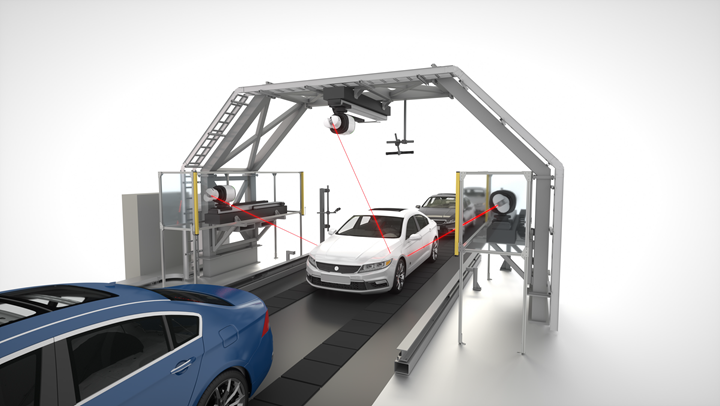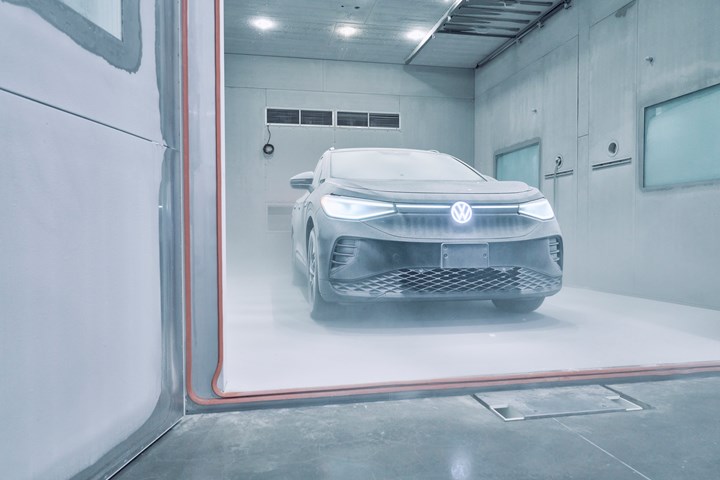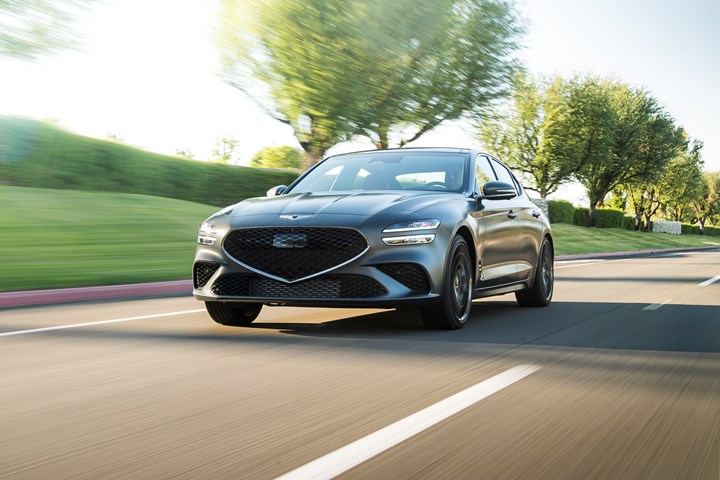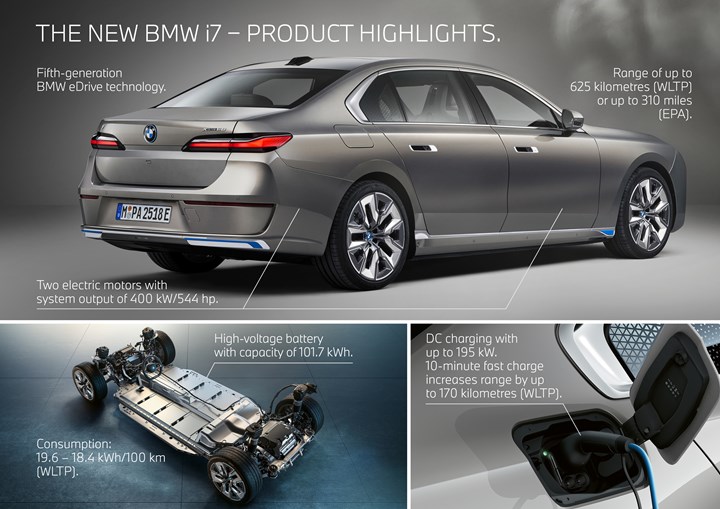on Lamborghini, Mazda, Polestar, VW, Genesis, Mercedes & Yes, Even More
Lamborghini sets a production record. . .Mazda sets a limit to carbon emissions. . .Polestar seeks alternative materials. . .VW opens a battery lab. . .Genesis builds a nice sports sedan. . .Mercedes and electric bikes. . .
#robotics
Lambo Sets a Production Record—for Lambo

Inside the Lamborghini plant where the Urus is being assembled. (Image: Lamborghini)
Generally, an assembly plant will produce one vehicle per minute.
So it is a bit surprising to learn that Automobili Lamborghini is absolutely chuffed about the production record it has set with its Urus SUV, which debuted in the market in 2018.
The company has produced more of these SUVs in a shorter period of time than any other vehicle it has ever built.
In four years, it has built 20,000 Urus models. That, according to the company, is a “new production record.”
There are generally thought to be 2,087 work hours in a year.
So over four years, 8,348 hours.
In a plant running 60 jobs per hour, that would be 500,880 units.
Clearly things are done more artisanally in Sant’Agata Bolognese.
To build the Urus, Lamborghini doubled the size of its factory to 160,000 square meters and hired more than 500 people.
///
Mazda’s Steps Toward Carbon Neutrality

Building the Mazda CX-60, which is not available in the U.S. market. It is the first Mazda with a PHEV option. (Image: Mazda)
Not just because this picture reminds us of the one above it. . .
Mazda is working toward carbon neutrality in all of its production operations by 2035 because, as the company puts it, it thinks it is “the core responsibility of all automotive manufacturers to do their part in curbing global warming by reducing CO2 emissions in every step of vehicle production, including manufacturing, transport, vehicle usage and recycling.”
Seems like everyone focuses on the usage stage. But the others matter. A lot.
Mazda is taking a three-pronged approach:
- Energy conservation. The focus here is on production operations. For example, it is developing low-temperature curing paints to reduce thermal energy needs.
- Renewable energies. This goes outside the walls of the factories to the local communities, such as working with the Carbon Neutral Electricity Promotion Subcommittee in the Chugoku region, which is working to build out carbon-neutral electricity in the area.
- Carbon-neutral fuels. All major manufacturing facilities have an array of vehicles operating inside them. Mazda will be working to utilize carbon-neutral fuels for in-house transportation.
Mazda also intends to have its entire supply chain carbon-neutral by 2050.
///
Polestar on the Runway (The Fashion One)

“Textiles and soft interior materials in particular remain a huge a challenge on our quest to deliver on climate neutrality.” Fredrika Klarén, Head of Sustainability at Polestar. (Image: Polestar)
Last week the Global Fashion Summit was held in Copenhagen.
No, I’ve not noted that by accident.
But because Polestar was the main partner at the event, which focused on sustainability in fashion.
“The fashion and automotive industries are two heavy emitters of CO2e*. Both industries share many complex challenges when it comes to sustainability, related to resource use, human rights and transparency. We are now in the ‘climate decade’ and working in silos just won’t cut it.”-- Fredrika Klarén, Head of Sustainability at Polestar
Klarén also said, “The biggest obstacle to sustainable innovation is our own lack of imagination – we need to reimagine everything in order to make real change. This starts with collaboration within, and beyond, our industry.”
So, fashion.
In April 2021the EV company announced the “Polestar 0” project.
As it describes the undertaking in its 2021 Sustainability Report:
“The project sets out to eliminate all emissions from raw material extraction, material manufacture, product manufacture and end-of-life. The Polestar 0 project will therefore require us to operate, and cooperate, to an extent not seen before. Not only to advance existing technology, but to tap into solutions that are still in the ideation stage.”
So, yes, even fashion companies matter to this undertaking.
*CO2e is “carbon dioxide equivalent” and takes into account other greenhouse gases, too.
///
Benefits of Multiple Sensors—for Measurement

There aren’t really red beams impinging on the vehicles in assembly, but an illustration of how scanning is performed to measure gaps and flush. (Image: Nikon Metrology)
Developers of advanced advanced driver assistance systems (ADAS)—like GM’s forthcoming Ultra Cruise, which goes beyond the capabilities of Super Cruise—know that redundant sensors is important. So while Super Cruise uses cameras, Ultra Cruise will use cameras, radars and lidar, which explains why it can not only handle hands-free driving on highways, but even accommodate city and suburban streets.
It came as a bit of a surprise to learn of a metrology system that also uses more than one type of sensor: the APDIS Laser Radar.
Making it
It is used to measure vehicles on the assembly line.
Nikon Metrology has announced the availability of the APDIS Gap & Flush System that can track and measure at conveyor speeds up to 140 mm/second.
In operation the vehicle position is determined by 3D sensors. Then when the vehicle is in the system, it is measured by three Laser Radar units that are mounted on linear rails more than 0.5 meters away from the body.
The sensors move along the rails as the vehicle moves through the system.
The system is capable of providing a dynamic repeatability of >0.150 mm on flush and 0.300 mm on gaps.
///
VW Opens Battery Lab in Chattanooga

The drive-in climate chamber in the VWoA battery lab can provide an environment that goes from -94°F on the chilly side to +266°F on the warm end. Here, of course, is the big chill. (Image: VWoA)
Volkswagen of America (VWoA) has established a $22-million Battery Engineering Laboratory on its grounds in Chattanooga, Tennessee.
The 32,000-square foot lab is one of four that Volkswagen Group operates globally, with the others:
- Braunschweig, Germany
- Shanghai, China
- Changchun, China
(Get a sense that in China batteries are quite the thing?)
VWoA is spending $7.1-billion in North America on R&D, production and other operations (e.g., it spent $800 million to get the Chattanooga plant prepared to produce the ID.4 EV, which will launch at the plant in a few months).
According to Scott Keogh, VWoA president and CEO, the company is looking for a site for battery production operations in North America.
Which helps explain the lab, where 30 engineers are focusing on climatic, mechanical, electrical and corrosion testing of battery cells and packs.
///
2022 Genesis G70 AWD 3.3T Sport Prestige

The Genesis G70: style with performance that will make you smile. (Image: Genesis)
Directly to the right of the name of the G70 on the vehicle Monroney (a.k.a., “window sticker”) there is a list under the heading “The Genesis Experience”:
- 3 yr/36K Complimentary Maintenance
- 3 yr/36K Complimentary Service Valet*
- 3 yr Complimentary Genesis Connected Services*
- 3 yr Complimentary Map Care
- *Exclusions may apply, see retailer for details
Which may be all good, but really undermines what I would suggest “The Genesis Experience” really is vis-a-vis the G70:
It is a sport sedan that is enjoyable and comfortable to drive.
Not that there is anything wrong with that list of complementary offerings (though exclusions may apply). But those are not the reasons why someone is going to buy a car. Maybe they provide a nudge, but it is the metal, leather, glass, rubber and the way they are all orchestrated that is the decision driver.
No skimping
The car is stylish from the LED quad headlights all the way back around to the LED quad taillights. (Quad is key here because it underlines the fact that the Genesis designers and engineers didn’t skimp.)
The car is responsive, with a 365-hp 3.3-liter V6 mated to an 8-speed automatic with paddle shifters.
The car is well appointed on the inside with a 12-way power driver seat with four-way power lumbar and a 12-way power passenger seat with four-way power lumbar (typically, the driver seat gets much more capability than the passenger—again, this is sort of like that aforementioned quad lighting: more is, typically, better).
Serious engineering
Those of you with an engineering orientation may be surprised—and pleased—to know that when the G70 was introduced as a MY 2019 vehicle in 2018, Albert Biermann, then-President and Head of Vehicle Performance Division of Hyundai Motor Group*, the huge hire that Hyundai made in 2014, as Biermann had spent three decades at BMW tuning chassis like a maestro, said:
“We used high-strength steel, aerospace-grade adhesives and strategic lightening with aluminum to create the ideal balance of stiffness, light weight and competitiveness.”
Not only high-strength, but hot-stamped steels are used. Aluminum is used in applications including the hood and strut tower reinforcement bars.
Biermann: “The foundation for any kind of car that performs well dynamically is an incredibly rigid platform.”
What this means is that not only the vehicle stylish (the 2022 model has been redesigned so what the company describes as a “rigid Nürburgring-tuned chassis” is still underlying the sheet metal) and well-appointed, but it is engineered so that it is able to perform well whether you are simply taking it on a casual drive or hammering the accelerator while on that open stretch of curvy blacktop. (Yes, yes, it is more likely the former than the latter, but should you find yourself there. . . .)
Cost effective
And you get it without having to take out a second mortgage: the price for the Sport Prestige vehicle with the 3.3-liter turbocharged engine (the base model has a 2.0-liter), AWD and amenities including a heads-up display, Nappa leather seats, electronically controlled suspension, Brembo brakes, and more, is $52,650.
*Biermann retired from that position in December 2021.
///
You Can’t Buy a Mercedes Formula E Car. But You Can a Bike

You can’t buy the Mercedes electric race car. But you can buy an electric Mercedes bike. (Image: n+)
“Intelligent electric mobility - this is what the new Mercedes-Benz EQ product brand stands for. An attractive design, exceptional driving fun, high levels of suitability for everyday use and maximum safety are further attributes.”
- Attractive design.
- Driving fun.
- Everyday use.
Which brings us to the Mercedes-EQ Formula E Team e-bikes.
That’s right.
Not merely something from the Mercedes-Benz EQ passenger vehicle lineup, but something that is affiliated with the electric vehicle racing team.
There are four bikes in the lineup: Formula E Team, Silver Arrows, Silver Arrows Sport, Championship Edition.
They are all powered by lithium-ion batteries. The Formula E Team and Silver Arrows have 250-W motors. The Silver Arrows Sport has a 500 W motor. And the Championship Edition has two motors, with a total output of 750 W.
While one might think that these would have carbon fiber frames, that’s not the case. It’s aluminum 6061 across the board.
However, all the bikes have a carbon-reinforced belt drive.
Top speed for the Formula E and Silver Arrows is 20 mph. It is 25 mph for the Sport and 28 mph for the Championship.
The range for the Formula E is 43 miles while it is 74 miles for the other three bikes.
Pricing?
First keep in mind these are Mercedes-EQ Formula E Team e-bikes.
They range from $3,450 for the Formula E Team model to $5,800 for the Championship Edition.
Another thing to keep in mind.
Mercedes-Benz has announced it will end its participation in Formula E at the end of Season 8. That’s as in August. A few weeks from now.
The bikes will be available beyond that, but if you want to feel like you’re part of the series, act fast.
///
Electrification Issues in the EU

Europe is going electric: BMW i7. (Image: BMW)
Infrastructure for electrified vehicles, like the weather, is something that everyone talks about.
But unlike the weather, something can be done about infrastructure.
Which makes the situation in the European Union (EU) interesting, as there is the government on the one hand and the OEMs on the other, and there is talk between them but different understandings.
A bit of background
The EU (consisting of 27 member states) is committed to being carbon neutral by 2050.
The EU vehicle manufacturers (represented by the ACEA) are committed to bringing net CO2 emissions down by 55% compared to 1990 levels by 2030.
All good.
The EU had passed the Alternative Fuel Infrastructure Directive (AFID) in 2014. It provided direction that would facilitate the carbon reduction.
The AFID has now become the AFIR—a Regulation.
And the ACEA (BMW Group, DAF, Daimler Truck, Ferrari, Ford, Honda, Hyundai, IVECO, Jaguar Land Rover, Mercedes-Benz, Groupe Renault, Stellantis, Toyota, Volkswagen Group, Volvo, and Volvo Group) is pleased it has become a regulation, but according to the group, the members “are seriously concerned about the lack of ambition of this proposal.”
Who would have thought that industry would say that government regulations are insufficiently ambitious?*
The position ACEA is taking is essentially that there needs to be a robust infrastructure if private and commercial consumers are going to make the switch to zero-emissions vehicles.
Where’s the energy?
The ACEA points out 70% of all EV chargers are in three EU countries (29.7% in the Netherlands, 20.4% in France and 19.9% in Germany).
Remember: there are 27 countries.
There are 124 hydrogen fueling stations—all in 10 countries.
There are some 4,000 natural gas filling stations—two thirds of which are in Italy and Germany.
ACEA says the AFIR doesn’t sufficiently address a wide-spread implementation of facilities.
More granular
There is agreement between the European Commission and the ACEA that in 2030 there will be:
- 34.4 million battery electric vehicles (BEVs)
- 13.7 million plug-in hybrids (PHEVs)
- An average annual mileage of 13,414 km for both types of what they call “electrically chargeable vehicles” (ECVs)
But then there is a “but”:
- ACEA believes in 2030 vehicles will have bigger batteries to provide longer range, which means energy consumption on the order of 20 kW/100 km. The Commission thinks it will be 12 kW/100 km.
- The Commission reckons 40% of energy supplied to ECVs will be from public chargers. ACEA thinks it will be “at least” 60%
- The Commission thinks that in 2030 the charging power will be 7.7 kW and 104 kW (for fast chargers). The ACEA figures: 11 kW and 185 kW
- ACEA thinks the annual energy demand will be 90 TWh for BEVs and 27 TWh for PHEVs; the ADIR has the respective numbers at 68 and 18.
And there are pages more of discrepancies.
If there is any good news, it is that the OEMs and the EU Commission are both seriously addressing the electric transition.
Analogous parties in the U.S. should pay close attention.
*However, it should be noted that last week the European Parliament voted (339 in favor, 249 against, 24 abstentions) to mandate the sale of only zero-emission passenger vehicles starting in 2035, meaning the end of internal combustion engines for new products in the EU.
The ACEA essentially thinks this is more than a bit of over-reach: “But given the volatility and uncertainty we are experiencing globally day-by-day, any long-term regulation going beyond this decade is premature at this early stage. Instead, a transparent review is needed halfway in order to define post-2030 targets,” ACEA president Oliver Zipse said in response to the vote. Zipse also happens to be the CEO of BMW
RELATED CONTENT
-
On Traffic Jams, Vehicle Size, Building EVs and more
From building electric vehicles—and training to do so—to considering traffic and its implication on drivers and vehicle size—there are plenty of considerations for people and their utilization of technology in the industry.
-
On Advanced Design, Brain Function, and Quantum Computing
All about a solar sedan, a new GM design campus, Volvo’s impressive XC90, Porsche first-half sales, Nissan’s brain studies (!), Lucid Care for Lucid Air, and VW’s quantum computing
-
On Electric Pickups, Flying Taxis, and Auto Industry Transformation
Ford goes for vertical integration, DENSO and Honeywell take to the skies, how suppliers feel about their customers, how vehicle customers feel about shopping, and insights from a software exec


.jpg;width=70;height=70;mode=crop)






